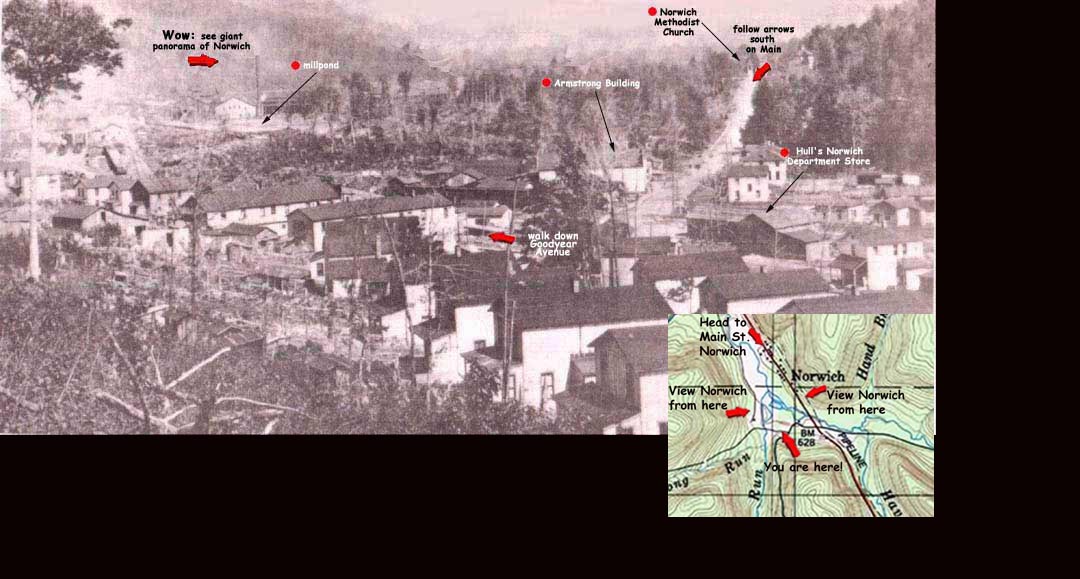Welcome to Norwich, PA
1910 Norwich, PA: The Hillside Overlooking Downtown Norwich

photo credit: Potter County Historical
Society
View
panorama of Norwich
Norwich Interactive Map
Link
to Merle Dickinson and His Book
Return to Main Smethport History page
Norwich was a bustling little town...
before it vanished
Bradford Era. Thursday, May 27,
1993
By Waldo Pettenati
Travelers along Route 46 South
rarely realize that at the base of Emporium hill a town of 5,000 or more inhabitants
once lived, worked and played. Today, wild turkey, grouse, deer and bear roam
the brush and feed in among the trees which line the highway. Some 5,000 acres
of woodland-at one time denuded of the original virgin hemlock and hardwoods-
are controlled bye the Pennsylvania Game Commission.But the location, once,
was home to Norwich, Pa., said to be one of the busiest towns in the Commonwealth
of Pennsylvania in the 1900s.Like a shooting star, Norwich rose briefly to prominence
and just as quickly vanished.Its rise and fall pantomimed the timber industry
whose voracious appetite for virgin trees resembled a horde of locusts, swarming
into an area, feasting, and then moving on .Norwich's birth came in 1910 with
that of the Goodyear Lumber Co., nestled on the headwaters of the Potato Creek,
which operated a huge sawmill employing more than 100 men.The mill had two large
band saws whose hum and song could be heard throughout the area, transforming
virgin hemlock and hardwood logs into usable lumber. A planing mill operated
in a separate building as did a boiler house containing five large boilers.
The equipment for the boiler operation was manufactured at the Clark Brothers
shops at Belmont, NY.Eventually, Norwich grew to a population of about 5,000
inhabitants including about 4,000 "wood hicks" who lived in shanties in the
nearby woods cutting not just logs for the mill but chemical wood for the Keystone
Chemical Plant, one of the largest chemical plants in Pennsylvania at the time.In
its prime at Norwich, the Goodyear Co. built a water plant, laying water pipes
in all parts of the town supplied from a dam built on one of its many nearby
brooks. All houses in Norwich were supplied with pure spring water.Every
home in Norwich was supplied with the then-known modern conveniences of a bathroom,
hot and cold water, plus natural gas for heating and lighting, plus a sewage
system. The mill itself and the nearby vicinity had electric lights supplied
by the mill generators.Besides the large lumber mill, a kindling factory and
railroad shops, Norwich contained several churches, both Catholic and Protestant.
There were various lodges, a fire department, a picture show, hotel and various
businesses.Among the most prosperous business was the Charles Hull Co. which
was said to compete with many of the large city department stores of the time,
containing everything from toothpicks to baled hay.Every imaginable need was
available to consumers who were isolated some distance from the larger centers
of population. Mr. Hull reportedly carried over $2,000 worth of eggs in
cold storage.It was believed by the people of the time that Norwich would be
an important factor in the future of county affairs. But such was not
to be the case.In about 1920, local newspapers began printing the demise of
the once bursting, bustling village of Norwich.In July of that year, the last
log was sawed at the mammoth mill at Norwich. And the mill itself, one
of the largest of its kind in this part of the United States, was moved to Clarion
County where a large tract of timber land awaited the building of a new lumbering
town.The last vestige of Norwich were removed when the Potato Creek Railroad,
which connected Norwich with the outside world, at Liberty, was removed.
At Liberty, it was connected to the Pennsylvania Railroad.The closing of the
lumber company resulted in a general migration of people away from the area.
Most of the houses were torn down and transported to Austin and to other towns
nearby.In its 10 years, the Norwich operation had cleared approximately 26,000
acres, taking nearly 400 million feet of virgin hemlock and hardwood lumber.At
the same time, wood cutters hand cut and delivered 90 million feet of hardwood
for staves to the Pennsylvania Stave Co. at nearby Betula, and thousands of
cords of chemical wood to the Keystone Chemical Plant.But when its bounty was
gone, Norwich like a western mining town, became a deserted ghost town, ending
much as it had begun.
